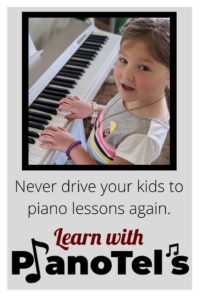Can I tell you how much I love my student’s piano binders? Before the life of the binder, any worksheets, reference sheets, homework assignments, composer studies, etc. would end up crumbled up on the floor of my student’s vehicles as they drove home. Any hope of referring to them again were lost as soon as they walked out the door with them. It’s almost as if we never did anything in the first place. Not anymore!
How do you keep a piano student organized? Creating a binder keeps the student’s piano materials in one, easily accessible place. It can be referred back to, will help to keep all the piano materials in one place, and will aid in keeping a connection from the piano studio to their home. These binders become a student’s best friend as it becomes ridiculously helpful to their piano education.
I will tell you all about what I have done to make my piano student’s binders a success and why I am so passionate about this aspect of my studio.

The Vision of a Piano Student’s Binder
I want you to truly understand where I am coming from in why I feel that these binders are super important. So bear with me while I paint for you my vision of what a piano student’s binder should be. This is a place where a student can refer to for inspiration and motivation. This is a treasured item by the student. A place where music becomes more personal for them. This is a place that is to help them when they get “stuck”. A place to help jog their memory. A place to record their thoughts, goals, and inspiration. This binder becomes more and more a personal music program for each student as it is adapted to the needs and progression of the student. This binder is very intentional. Each thing that is in there is there for a purpose.
Can you see that my purpose of being a piano teacher is help my students develop a well-rounded musician, not just to simply develop a piano player? I can’t do it all and I am certainly not here to teach them voice or any other instrument other than the piano, but what an opportunity it is as a teacher to truly develop musicianship and help our kids to not only know how to play piano, but to appreciate music, recognize it’s beauty, and be well versed and practice as a well balanced whole. Okay, off my soap box and back to the binder.
What it is NOT
This binder is NOT a place for fluff. It is not a place in which to make the teacher happy by submitting to whatever the teacher decides is best. It is not to be stepped on or thrown about and it is definitely NOT to be forgotten, especially when going to and from lessons.
Types of Binders
For beginning to intermediate students, a 1″ binder should be sufficient to start with. Advanced students will likely need a bigger binder to keep their accumulating music and music reference items in. Make sure the binder is sturdy. It will go through a lot and you don’t want to have to replace it very often, so spend a little more to make sure its a good one. Buy a binder that has a place to slide in a cover.
Piano Binder Cover
This is by far the absolute most important thing you will do for your student. Period. I’m not kidding. I believe that the piano binder cover should portray everything that the student believes in, works for, and sees in him/herself when it comes to piano. I take almost a whole lesson to work on this piano binder cover with my student, crafting it to be exactly what the student would like it to be. Someday, I will post my lesson plan for this so you can get the whole picture. But for now, just take a minute to think about how important it is that this piano binder cover to become a reminder and an inspiration for your student. Every time they pick up their music and their binder, they will see this. So take the time to make sure the cover really represents the student’s goals and inspiration.
For more on piano binder covers, see my article at pianotels.com/pianobindercovers.
Tab #1: Practice Journals
You will need dividers. I buy and label all the sections for the kids ahead of time, just to make sure it is done well. The first section, tab, divider, or whatever you decide to use, label Practice Journals. This is one of the most used, most important tabs in the binder. This is your connection from when the student walks out the door to when they walk back in for their next lesson. I have found it wise to keep this section fairly “clear”. This is the section that is likely to become cluttered and fill up the rest of the binder. So take care that we keep only what is minimal in this section. This is what I use for my Practice Journal.
Tab #2: Tools
I like to call this section “tools”. This is the section that I use for putting in anything that the student can refer to again. It is our piano’s tool belt. Oftentimes, because I want these papers to last, I will have these papers printed out on cardstock or put in sheet protectors. In my experience, I prefer printing out these kinds of documents on cardstock simply because they fit a little better with the tabs/dividers. But that’s really just a matter of preference and you can do whatever you prefer. I would just strongly suggest doing something to help these pages last a little longer as the student’s flip through them. I even like using variations in color so when we refer back to them, we can remember them even better. Here are a few items that I have in the tool belt: Piano Practice MUST DO’s, Learning a New Song, Self Evaluation.
Tab #3: Music Theory Worksheets
Most of my music theory is taught through games and manipulatives. But every once in a while I have a worksheet for them. I try and do this intentionally so that they can use this a reference as well. I value my time with my student’s highly, and so I try to avoid busy work. The worksheets I do give them are thought-out and intended to give them a legitimate learning experience. This is the place where those worksheets are kept. You may think that this divider can get full and while it is true that every once in a while, you may need to clear out some worksheets here. But if you are careful about why and how often you have them filling out these worksheets, then this section will be more valuable to them and not just full of “fluff”.
Tab #4: Music History
Whenever we study a composer, or a particular piece of music, it goes here. We, meaning both my students and myself, love this section. This is where we give our students some “culture” and truly develop their appreciation for all types of music in all the ages. When I give my students a pop quiz, I will pull information from out of this section of the binder and quiz them. It is so fun to be able to see their excitement as they recognize songs, or can identify a particular trait of a musician, or whatever it is we have stored in this cool little section of the binder.
Tab #5: Sheet Music
Okay, I totally get that this section can get huge. That’s the ideal, right? That comes with time, experience, and the progression of the student. At least the way I do it, most of my beginning to intermediate students use a lesson book to work through their lessons. In case you were wondering, this is what I use here for my method books. So this section is mainly used for songs that we pull out and learn that are above and beyond the method book. Once the students get more advanced, you can create a separate binder for this if you need. Or, as I prefer, I still have it all in one binder, it just happens to be big. It is like a two-for-one: not only do my students learn piano, they build muscle as they carry this honking huge binder around.
Composing Binder
Oh, I just love this part too. I have to say — there is something absolutely amazing when your kids come up with their own creations. Talk about fun. And wouldn’t it be such a tragedy if this all got lost? So, at least for me, I like to keep my composing stuff in a whole new binder. It doesn’t have to be big. We don’t compose all the time, so I don’t always require my students to bring this along as well. But we have plenty of material to put in this and I think it deserves its own binder. But if you don’t want to do that, then by all means, just create another tab for this section. If I were you, I would put it before tab #5, but that’s up to you. I will never know either way and I promise I won’t hunt you down if you don’t do it exactly my way.
Let’s Wrap This Up
Wow, you probably had no idea what a mouthful you would get about my piano student binders. I hope you get the vision of just how cool these are and what an important part of what makes my studio successful. Don’t underestimate these bad boys. Take the effort to really make these binders worth it and your students will truly appreciate it! They will always be able to use these binders when you are their teacher and especially when they have taken flight and are on their own.
Tel loves her life as a piano player, a piano teacher, and a mom. Amid piano blogging, piano teaching, and piano playing, she loves a chance to fit in a good exercise class, volunteer at her kids’ school and at her church, and go on long dates with her husband. Full bio at About Tel.


